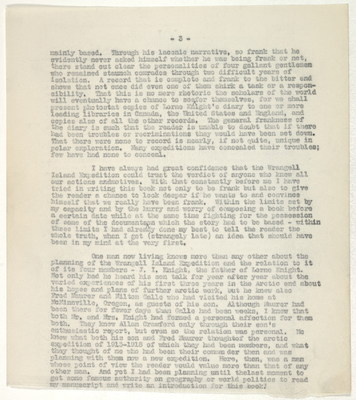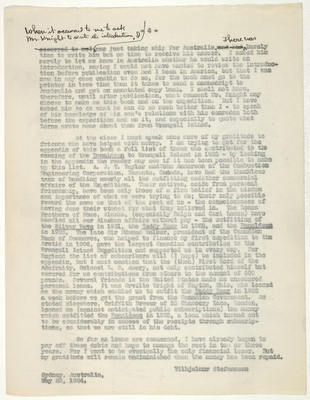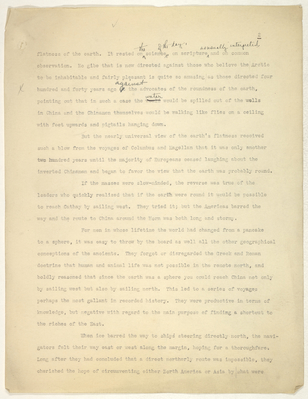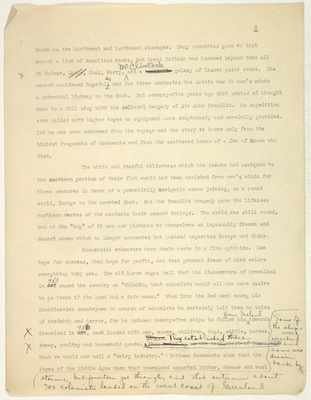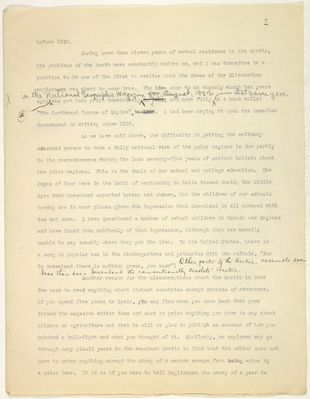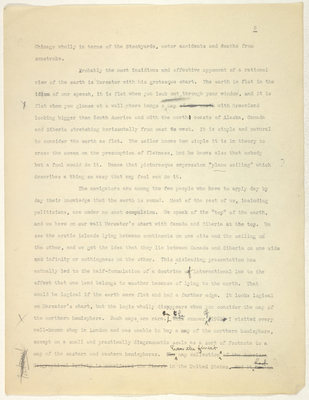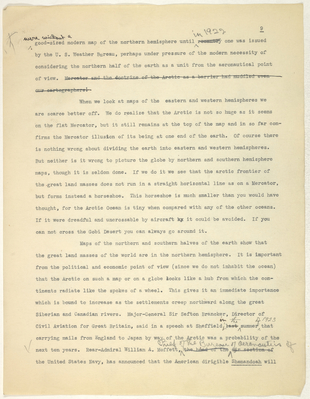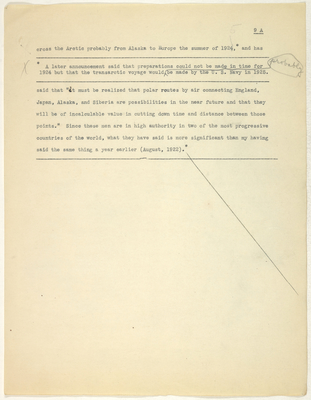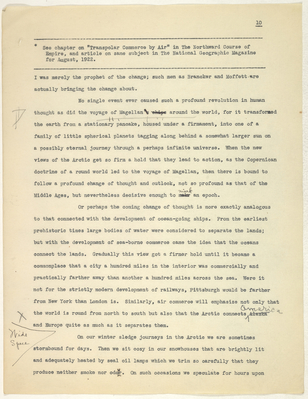Pages That Need Review
stefansson-wrangel-09-26-001
stefansson-wrangel-09-26-001-003
-3mainly based. Through his laconic narrative, so frank that he evidently never asked himself whether he was being frank or not, there stand out clear the personalities of four gallant gentlemen who remained staunch comrades through two difficult years of isolation. A record that is complete and frank to the bitter end shows that not once did even one of them shirk a task or a responsibility. That this is no mere rhetoric the schholars of the world will eventually have a chance to see for themselves, for we shall present photostat copies of Lorne Knight's diary to one or more leading libraries in Canada, the United States and England, and copies of all the other records. The general frankness of the diary is such that the reader is unable to doubt that if there had been troubles or recriminations they would have been set down. That there were none to record is nearly, if not quite, unite in polar exploration. Many expeditions have concealed their troubles; few have had none to conceal.
I have always had great confidence that the Wrangell Island Expedition could trust the verdict of anyone who knew all our actions and motives. With that constantly before me I have tried in writing this book not only to be frank but also to give the reader a chance to look deeper if he wants to and convince himself that we really have been frank. Within the limits set by my capacity and by the hurry and worry of composing a book before a certain date while at the same time fighting for the possession of some of the documents on which the story had to be based - within these limits I had already done my best to tell the reader the whole truth, when I got (strangely late) an idea that should have been in my mind at the very first.
One man now living knows more than any other about the planning of the Wrangell Island Expedition and the relation to it of its four members - J. I. Knight, the father of Lorne Knight. Not only had he heard his son talk for year after year about the varied experiences of his firat three years in the Arctic and about his hopes and plans of further arctic work, but he knew also Fred Maurer and Milton Galle who had visited his home at McMinville, Oregon, as guests of his son. Although Maurer had been there for fewer days than Galle had been weeks, I knew that both Mr. and Mrs. Knight had formed a personal affection for them both. They knew Allan Crawford only through their son's enthusiastic report, but even so the relation was personal. He knew what both his son and Fred Maurer thought of the arctic expedition of 1913-1918 of which they had been members, and what they thought of me who had been their commander then and was planning with them now a new expedition. Here, then, was a man whose point of view the reader would value more than that of any other man. And yet I had been planning until the last moment to get some famous authority on geography or world politics to read my manuscript and write an introduction for the book!
stefansson-wrangel-09-26-001-004
- 4 -
occurred to meWhen it occurred to me to ask Mr. Knight to write the introduction, I was just taking ship for Australia there was barely time to write him but no time to receive his answer. I asked him merely to let me know in Australia whether he would write an introduction, saying I would not have wanted to review the introduction before publication even had I been in American, but that I was now in any case unable to do so, for the book must go to the printer in less time than it takes to send a manuscript to Australia and get an annotated copy back. I shall not know, therefore, until after publication, what comment Mr. Knight may choose to make on this book and on the condition. But I have asked him to do what he can do so much better than I - to speak of his knowledge of his son's relations with his [?] both before the expedition and on it, and especially to quote what Lorne wrote home about them from Wrangell Island.
At the close I must speak once more of my gratitude to friends who have helped with money. I am trying to get for the appendix of this book a full list of those who contributed to the sending of the Donaldson to Wrangell Island in 1923 - by looking in the appendix the reader may see if it has been possible to make up this list. A. J. T Taylor and John Anderson of the Combustion Engineering Corporation, Toronto, Canada, have had the thankless task of handling nearly all the outfitting and other commerical affairs of the Expedition. Their motives, aside from personal friendship, have been only those of a firm belief in the wisdom and importance of what we were trying to do; their only possible reward the same as that of the rest of us - the consciousness of having done their utmost for what they believed in. The Lomen Brothers of Nome, Alaska, (especially Ralph and Carl Lomen) have handled all our Alaskan affairs without pay - the outfitting of the Silver Wave in 1921, the Teddy Bear in 1922, and the Donaldson in 1923. The late Sir Edmond Walker, president of the Canadian Bank of Commerce, who helped to finance my first expedition to the Arctic in 1906, gave the largest Canadian contribution to the Wrangell Island Expedition and supported us in every way. For England the list of subscribers will (I hope) be included in the appendix, but I must mention that the (then) First Lord of the Admiralty, Colonal L. S. Avery, not only contributed himself but secured for us contributions from others to the amount of 600 pounds. Several friends in the United States made me unsecured personal loans. It was Orville Wright of Dayton, Ohio, whho loaned me the money which enabled us to outfit the Teddy Bear in 1922 a week before we got the grant from the Canadian Government. As stated elsewhere, Griffith Brewer of 33 Chancery Lane, London, loaned me (against anticipated public subscriptions) the money which outfitted the Donaldson in 1923, a loan which turned out to be considerably in excess of the receipts through subscriptions, so that we are still in his debt.
So far as loans are concerned, I have already begun to pay off these debts and hope to manage the rest in two or three years. For I want to be eventually the only finanacial loser. But my gratitude will remain undiminished when the money has been repaid.
Vilhjalmur Stefansson Sydney, Australia, May 23, 1924.
stefansson-wrangel-09-26-001-006
flatness of the earth. It rested on the scienceof the day, on scripture as usually interpreted, and on common observation. No gibe that is now directed against those who believe the Arctic to be inhabitable and fairly pleasant is quite so amusing as those directed for hundred and forty years ago against the advocates of the roundness of the earth, pointing out that in such a case the wouldwater would be spilled out of the wells in Chine and the Chinamen themselves would be walking like flies on a ceiling with feet upwards and pigtails hanging fown.
But the nearly universal view of the earth's flatness received such a blow from the voyages of Columbus and Magellan that it was only another two hundred years until the majority of Europeans ceased laughing about the inverted Chinamen and began to favor the view that the earth was probably round.
If the masses were slow-minded, the reverse was trye of the leaders who quickly realized that if the earth were round it would be possible to reach Cathay by sailing west. They tried it; but the Americas barred the way and the route to China around the Horn was both long and stormy.
For men in whose lifetime the world had changed from a pancake to a sphere, it was easy to throw by the board as well all the other geographical conceptions of the ancients. They forgot or disregarded the Greek and Roman doctrine that human and animal life was not possible in the remote north, and boldly reasoned that since the earth was a sphere you could reach China not only by sailing west but also by sailing north. This led to a series of voyages perhaps the most gallant in recorded history. They were productive in terms of knowledge, but negative with regard to the main purpose of finding a shortcut to the riches of the East.
When ice barred the way to ships steering directly north, the navigators felt their way east or west along the margin, hoping for a thoroughfare. Long after they had concluded that a direct northerly route was impossible, they cherised the hope of circumeventing either North America or Asia by what were
stefansson-wrangel-09-26-001-007
3
known as the Northwest and Northeast passages. Many countries gave to that search a list of dauntless names, but Great Britain was honored beyond them all in Hudson, Davis, Cook, Parry, McClintockand a galaxy of lesser polar stars. The search continued gopefully and for three centuries the Arctic was in men's minds a potential highway to the East. But seventy-five years ago that period of thought came to a full stop with the colossal tragedy of Sir John Franklin. No expedition ever sailed with higher hopes or equipment more sumptuously and carefully provided. Yet no one ever returned from the voyage and the story is known only from the tiniest fragments of documents and from the scattered bones of a few of those who died.
The white and fearful wilderness which the Greeks had assigned to the northern portion of their flat world had been banished from men's minds for three centures in favor of a potentially navigable ocean joining, on a round world, Europe to the coveted East. But the Franklin tragedy gave the lifeless northern wastes of the ancients their second innings. The world ’was still round, but at the "top" of it men now pictured to themselves an impassably frozen and desert ocean which no longer connected but instead separated Europe and China.
Commercial endeavors have their roots in a firm optimism. Men hope for success, they hope for profit, and that general frame of mind colors everything they see. The old Norse sagas tell that the discoverers of Greenland in 987983named the country so "thinking that colonists would all the more desire to go there if the land had a fair name." Then Eric the Hed went among his Scandinavian countrymen in search of colonists he certainly told them no tales of hardship and terror, for he induced twenty-five ships to follow him from Icelandtowards Greenland in 986, each loaded with men, women, children, dogs, cattle, horses, sheep, poultry and household goods. They established there what we would now call a "dairy industry." Vatican documents show that the Popes of the Middle Ages knew that Greenland exported butter, cheese and wool some of the ships were wrecked and some were driven back by storms, but fourteen got throuhg and that autumn about 700 colonists landed on the west coast of Greenland.
stefansson-wrangel-09-26-001-011
before 1930.
During more than eleven years of actual residence in the Arctic, the problems of the North were constantly before me, and I was therefore in a position to be one of the first to realize that the dream of the Elizabethan navigators was about to come true. The idea came to me vaguely about ten years ago; In the National Geographic Magazine for August 1922 was put into print tentatively and more fully that same year in a book called "The Northward Course of Empire." I had been urging it upon the Canadian Government in writing since 1918.
As we have said above, the difficulty in getting the ordinary educated person to take a fully rational view of the polar regions is due partly to the recrudescence during the last seventy-fice years of ancient beliefs about the polar regions. This is the fault of our school and college education. The Popes of Rome were in the habit of mentioning in bulls issued during the Middle Ages that Greenland exported butter and cheese, but the children of our schools to-day are in most places given the impression that Greenland is all covered with ice and snow. I have questioned a number of school children in Canada and England and have found them uniformly of that impression, although they are usually unable to say exactly whre they got the idea. In the United States, there is a song in popular use in the kindergartens and primaries with the refrain, "For in Greenland there is nothing green, you know": Other parts of the Arctic resemble less than does Greenland the conventionally desolate Arctic.
Another reason for the misconceptions about the Arctic is that few care to read anything about distant countries except stories of adventure. If you spend five years in Spain, you may find when you come back that your friend the magazine editor does not care to print anything you have to say about climate or agriculture but that he will be glad to publish an account of how you watched a bull-fight and what you thought of it. Similarly, an explorer may go through many placid years in the remotest Arctic to find that the editor does not care to print anything except the story of a narrow escape from being eating by a polar bear. It is as if you were to tell Englishmen the story of a year in
stefansson-wrangel-09-26-001-012
8 Chicago wholly in terms of the Stockyards, motor accidents and deaths from sunstroke.
Probably the most insidious and effective opponent of a rational view of the earth is Mercator with his grotesque chart. The earth is flat in the idiom of our speech, it is flat when you look out through your window, and it is flat when you glance at a wall where hangs a map with Greenland looking bigger than South America and with the north coasts of Alaska, Canada and Siberia stretching horizontally from east to west. It is simple and natural to consider the earth as flat. The sailor knows how simple it is in theory to cross the ocen on the presumption of flatness, but he knows also that nobody but a fool would do it. Hence that pictureesque expression "plane sailing" which ? describes a thing so easy that any fool can do it.
The navigators are among the few people who have to apply day by day their knowledge that the earth is round. Most of the rest of us, including politicians, are under no such compulsion. We speak of the "top" of the earth, and we have on our wall Mercator's chart with Canada and Siberia at the top. We see the arctic islands lying between continents on one side and the ceiling on the other, and we ge the idea that they lie between Canada and Siberia on one side and infinity or nothingness on the other. This misleading presentation has actually led to the half-formulation of a doctrine of international law to the effect that one land belongs to another because of lying to the north. That would be logical if the earth were flat and had a farther edge. It looks logical on Mercator's chart, but the logic wholly disappears when you consider the map of the northern hemisphere. Such maps are rare. In the summer of1923, I visited every well-known shop in London and was unable to buy a map of the northern hemisphere except on a small and practically diagrammatic scale as a sort of footnote to a map of the eastern and western hemispheres. Even the firstmap collections in the United states
stefansson-wrangel-09-26-001-013
were without a good-sized modern map of the northern hemisphere until in 1922 one was issued by the U.S. Weather Bureau, perhaps under pressure of the modern necessity of considering the northern half of the earth as a unit from the aeronautical point of view. Mercater and the doctrine of the Arctic as a barrier had muddled even our cartographers!
When we look at maps of the eastern and western hemispheres we are scarce better off. We do realize that the Arctic is not so huge as it seems on the flat Mercator, but it still remains at the top of the map and in so far confirms the Mercator illusion of its being at one end of the earth. Of course there is nothing wrong about dividing the earth into eastern and western hemisphere maps, thought it is seldom done. If we do it we see that the arctic frontier of the great land masses does not run in a straight horizontal line as on a Mercator, but forms instead a horseshoe. This horseshoe is much smaller than you would have thought, for the Arctic Ocean is tiny when compares with any of the other oceans. If it were dreadful and uncrossable by aircraft it could be avoided. if you can not cross the Gobi Desert you can always go around it.
Maps of the northern and southern halves of the earth show that the great land masses of the world are in the northern hemisphere. It is important from the political and economic point of view (since we do not inhabit the ocean) that the Arctic on such a map or on a globe looks like a hub from which the continents radiate like the spokes of a wheel. This gives it an immediate importance which is bound to increase as the settlements creep northward along the great Siberian and Canadian rivers. Major-General Sir Sefton Brancker, Director of Civil Aviation for Great Britain, said in a speech at Sheffield in thesummerof 1923 that carrying mails from England to Japan by way of the Arctic was a probability of the next ten years. Rear-Admiral William A. Moffett, Chief of the Burear of Aeronautics the Unites States Navy, has announced that the American dirigible Shenandoah will
stefansson-wrangel-09-26-001-014
9 A
cross the Arctic probably from Alaska to Europe the summer of 1924,* and has
-------------------------------------------------------------------------------------------------------------- *A later announcement said that preparations could not be madg in time for 1924 but that the transarctic voyage would probably be made by the U.S. Navy in 1925. --------------------------------------------------------------------------------------------------------------
said that "it must be realized that polar routes by air connecting England, Japan, Alaska, and Siberia are possibilities in the near future and that they will be of incalculable value in cutting down time and distance between those points." Since these men are in high authority in two of the most progressive countries of the world, what they have said is more significant than my having said the same thing a year earlier (August, 1922). *
stefansson-wrangel-09-26-001-015
10
* See chapter on "Transpolar Commerce by Air" in The Northward Course of Empire, and article on same subject in The National Geographic Magazine for August, 1922.
I was merely the prophet of the change; such men as Brancker and Moffett-are actually bringing the change about.
No single event ever caused such a profound revolution in human thought as did the voyage of Magellan around the world, for it transformed the earth from a stationary pancake, housed under a firmament, into one of a family of little spherical planets tagging along behind a somewhat larger sun on a possibly eternal journey through a perhaps infinite universe. When the new views of the Arctic get so firm a hold that they lead to action, as the Copernican doctrine of a round world led to the voyage of Magellan, then there is bound to follow a profound change of thought and outlook, not so profound as that of the Middle Ages, but nevertheless decisive enough to make markan epoch.
Or perhaps the coming change of thought is more exactly analogous to that connected with the development of ocean-going ships. From the earliest prehistoric times large bodies of water were considered to separate the lands; but with the development of sea-borne commerce came the idea that the oceans connect the lands. Gradually this view got a firmer hold until it became a commonplace that a city a hundred miles in the interior was commercially and practically farther away than another a hundred miles across the sea. Were it not for the strictly modern development of railways, Pittsburgh would be farther from New York than London is. Similarly, air commerce will emphasize not only that the world is round from north to south but also that the Arctic connects AmericaAmerica and Europe quite as much as it separates them.
Wide SpaceOn our winter sledge journeys in the Arctic we are sometimes stormbound for days. Then we sit cosy in our snowhouses that are brightly lit and adequately heated by seal oil lamps which we trim so carefully that they produce neither smoke nor odor. On such occasions we speculate for hours upon
stefansson-wrangel-09-26-001-016
Things for which we do not spare minutes where telephones ring and [cinemas] lurk around every corner. During the winters of 1914 to 1918 we used to talk a great deal about the coming era of northern development and the part which our respective countries would play therein. My companions were Canadians, Scots, Australians, Americans, Norwegians, South Sea Islanders - men from more than a dozen countries. We talked much of the importance of Spitsbergen to which Britain then had (it seemed to us) a stronger claim than any other nation. From the British point of view (and in the [?] of such secret informationas may [?] in Government archives) [should?] thought it one of the blunders of the Paris Conference that they gave away Spitsbergen to Norwar, not one-half aware of its mineral riches, not one-fourth informed as to its real climate, and apparently not at all conscious of its potential importance as a flying centre. From the point of view of Spitsbergen itself, it may be a blessing to be under an advanced country that is not too large to pay attention to it. To Norway itself, the arrangement gives a wonderful pioneering opportunity. Although the group is not quite as strategically placed in the Arctic as the Hawaiian Islands are in the Pacific, I fancy it will not be more than two or three decades until air lines radiate from Spitsbergen somewhat as steamship routes do now from Honolulu.
We talked of various other arctic islands from the point of view and among them of Wrangell, the history, climate and resources of which we knew, and the importance of which seemed clear to us.
Chapter II The Early History of Wrangell Island The history of Wrangell Island begins in the scientific theorizing of the eighteenth century. At that time it was supposed that most of the Arctic was occupied by a great continent of which Greenland was one corner. Another corner was thought to lie undiscovered just north of the northeastern coast of Siberia. An alternative view with similar implications was to the effect that the northwest corner of North America lay to the north of eastern Asia.
This was the time when the Russian Empire was expaning into Asia to form the country now politically described as Siberia, and the Czar's Govern-
